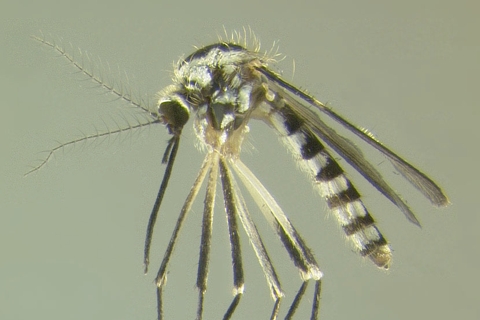
Studies of the larval stages of Aedes triseriatus (Eastern TreeHole Mosquito) indicate that the “tree hole” habitats in which these larva develop contain diverse microflora including the flavobacteria Elizabethkingia and Chryseobacterium. Extracts from these bacteria have many properties that might affect mosquito health, including antibacterial and anti-fungal activities. Understanding how these bacteria affect larval mosquito development has the potential to inform strategies for mosquito control.
Some initial work has been done by expressing Bacillus larvacidal toxins in some species of Gram-negative bacteria. However, only limited success was achieved using laboratory bacterial strains for such studies. Using environmental flavobacteria might prove to be a more useful approach. However, few molecular tools exist to study environmental flavobacteria. GFP reporters have been used to look at larval feeding, but autofluorescence in the pupae limit the usefulness of GFP-labeled strains for quantitative studies. Furthermore, environmental flavobacteria have unique transcription and translation machinery, and selectable markers and expression plasmids from proteobacteria do not function in these wild strains.
Chen and colleagues set out to generate molecular tools to study Flavobacterium hibernum, a fast-growing bacterium from native mosquito habitats. Their goal was to use these tools to see if A. triseratus larvae ingest and digest these bacteria and to test whether or not F. hibernum can be used to as a vector for larvacidal toxins directed against mosquito larvae. The results of their work were published in Applied and Environmental Microbiology .
To develop a reporter that avoided issues of autofluorescence background for quantitative studies on the feeding behavior, the researchers turned to NanoLuc® Luciferase, a small, bright luciferase derived from the sea shrimp Oplopphorus gracilirostris. This luciferase has been used in mammalian cells for many kinds of studies, but it has not been used as a reporter in bacterial cells prior to the work of Chen et al. They also looked at work with laboratory flavobacteria strains that used a promoter of outer membrane protein A (PompA) to drive reporter expression as a potential system that might also work with environmental flavobacteria strains.

NanoLuc® luciferase was cloned into the expression vector pFj29 and introduced into F. hibernum by conjugation. This strain was used for ingestion and digestion studies. The researchers first established that there was a linear relationship between the number of bacteria expressing NanoLuc® luciferase and the bioluminescence signal detected. They determined that the NanoLuc® signal was sufficiently sensitive to detect as few as 700 bacterial cells per milliliter. Additionally, NanoLuc® luminescence was stable: signal in controls with no larvae showed little variation. The researchers were able to determine ingestion rates, that pupae did not eat bacterial cells, and that 3rd and 4th instar larvae ingested the bacteria quickly.
For larvacidal studies, the researchers created an expression construct by inserting a GFP gene onto the N terminus of cry11A, the Bacillus subtillus anti-larval toxin. This antilarval construct was introduced into F. hibernum. Fluorescent colonies were selected and protein production was analyzed via Western blot and compared to GFP fluorescence. Because GFP fluorescence correlated with toxin production on Western, the strain with the highest GFP fluorescence was used for the toxicity studies. Initial studies indicated that this expression system produced enough larvacidal toxin to induce toxicity in A. triseriatus.
The authors of this study demonstrate the first application of NanoLuc® luciferase in bacteria, using it in environmental flavobacteria for ingestion and digestion studies with mosquito larvae. Additionally, they successfully created genetically engineered flavobacteria that could be used to deliver larvacidal activity against A. triseratus.
History
Updated April 2024 to correct broken link.
Michele Arduengo
Latest posts by Michele Arduengo (see all)
- An Unexpected Role for RNA Methylation in Mitosis Leads to New Understanding of Neurodevelopmental Disorders - March 27, 2025
- Unlocking the Secrets of ADP-Ribosylation with Arg-C Ultra Protease, a Key Enzyme for Studying Ester-Linked Protein Modifications - November 13, 2024
- Exploring the Respiratory Virus Landscape: Pre-Pandemic Data and Pandemic Preparedness - October 29, 2024
